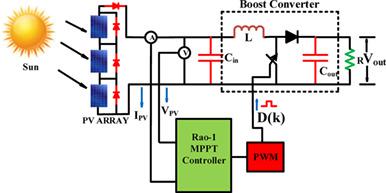当前位置:
X-MOL 学术
›
Int. Trans. Electr. Energy Syst.
›
论文详情
Our official English website, www.x-mol.net, welcomes your
feedback! (Note: you will need to create a separate account there.)
A novel maximum power point tracking technique based on Rao-1 algorithm for solar PV system under partial shading conditions
International Transactions on Electrical Energy Systems ( IF 1.9 ) Pub Date : 2021-07-22 , DOI: 10.1002/2050-7038.13028 Laxman Bhukya 1 , Anil Annamraju 1 , Srikanth Nandiraju 1
International Transactions on Electrical Energy Systems ( IF 1.9 ) Pub Date : 2021-07-22 , DOI: 10.1002/2050-7038.13028 Laxman Bhukya 1 , Anil Annamraju 1 , Srikanth Nandiraju 1
Affiliation

|
The performance of the Photovoltaic (PV) system is highly affected by fluctuating climatic conditions. Due to these changing climatic conditions, the irradiance diminishes, and it results in the non-linearity in voltage-power (P-V) curves of the PV system. Therefore, it is one of the reasons for the occurrence of the multiple peaks on P-V curves instead of a single peak. Therefore, it is challenging to track the global maximum power point tracking (MPPT) under these circumstances with traditional MPPT techniques viz. perturb and observe (P&O) and fuzzy logic control (FLC). Concerning global MPP tracking, this paper proposes a novel MPPT method based on a Rao-1 optimization algorithm. The proposed algorithm is used to overcome the drawbacks of the classical P&O, FLC, and PSO based MPPT techniques under partical shading conditions (PSCs) and rapidly changing atmospheric conditions viz. slow convergence speed and oscillation around the MPP. The proposed MPPT tracks the global MPP under any abnormal conditions like PSCs. To show the efficiency of the proposed MPPT a comparative assessment is performed with well-established MPPT methods in the literature. The simulation results witnessed that the proposed MPPT is more superior in improving the PV system performance under normal as well as under PSCs. The proposed MPPT over the PSO technique decreases the tracking time by 72.7% for pattern 1, 29.8% for pattern 2, 66.7% for pattern 3, 61.9% for pattern 5, 27.8% for pattern 6, and improves the tracking efficiency in all shading patterns.
中文翻译:

一种基于Rao-1算法的局部遮光条件下太阳能光伏系统最大功率点跟踪新技术
光伏 (PV) 系统的性能受气候条件波动的影响很大。由于这些不断变化的气候条件,辐照度降低,并导致光伏系统电压-功率 (PV) 曲线的非线性。因此,这是PV曲线上出现多个峰而不是单个峰的原因之一。因此,在这些情况下使用传统的 MPPT 技术跟踪全局最大功率点跟踪 (MPPT) 具有挑战性。扰动观察 (P&O) 和模糊逻辑控制 (FLC)。针对全局 MPP 跟踪,本文提出了一种基于 Rao-1 优化算法的新型 MPPT 方法。所提出的算法用于克服经典 P&O、FLC、和基于 PSO 的 MPPT 技术在局部阴影条件 (PSC) 和快速变化的大气条件下,即。缓慢的收敛速度和围绕 MPP 的振荡。提议的 MPPT 在任何异常条件(如 PSC)下跟踪全局 MPP。为了显示提议的 MPPT 的效率,我们使用文献中完善的 MPPT 方法进行了比较评估。仿真结果表明,所提出的 MPPT 在改善正常和 PSC 下的光伏系统性能方面更为优越。与 PSO 技术相比,所提出的 MPPT 使模式 1 的跟踪时间减少了 72.7%,模式 2 减少了 29.8%,模式 3 减少了 66.7%,模式 5 减少了 61.9%,模式 6 减少了 27.8%,并提高了所有阴影的跟踪效率模式。缓慢的收敛速度和围绕 MPP 的振荡。提议的 MPPT 在任何异常条件(如 PSC)下跟踪全局 MPP。为了显示提议的 MPPT 的效率,我们使用文献中完善的 MPPT 方法进行了比较评估。仿真结果表明,所提出的 MPPT 在改善正常和 PSC 下的光伏系统性能方面更为优越。与 PSO 技术相比,所提出的 MPPT 使模式 1 的跟踪时间减少了 72.7%,模式 2 减少了 29.8%,模式 3 减少了 66.7%,模式 5 减少了 61.9%,模式 6 减少了 27.8%,并提高了所有阴影的跟踪效率模式。缓慢的收敛速度和围绕 MPP 的振荡。提议的 MPPT 在任何异常条件(如 PSC)下跟踪全局 MPP。为了显示提议的 MPPT 的效率,我们使用文献中完善的 MPPT 方法进行了比较评估。仿真结果表明,所提出的 MPPT 在改善正常和 PSC 下的光伏系统性能方面更为优越。与 PSO 技术相比,所提出的 MPPT 使模式 1 的跟踪时间减少了 72.7%,模式 2 减少了 29.8%,模式 3 减少了 66.7%,模式 5 减少了 61.9%,模式 6 减少了 27.8%,并提高了所有阴影的跟踪效率模式。为了显示提议的 MPPT 的效率,我们使用文献中完善的 MPPT 方法进行了比较评估。仿真结果表明,所提出的 MPPT 在改善正常和 PSC 下的光伏系统性能方面更为优越。与 PSO 技术相比,所提出的 MPPT 使模式 1 的跟踪时间减少了 72.7%,模式 2 减少了 29.8%,模式 3 减少了 66.7%,模式 5 减少了 61.9%,模式 6 减少了 27.8%,并提高了所有阴影的跟踪效率模式。为了显示提议的 MPPT 的效率,我们使用文献中完善的 MPPT 方法进行了比较评估。仿真结果表明,所提出的 MPPT 在改善正常和 PSC 下的光伏系统性能方面更为优越。与 PSO 技术相比,所提出的 MPPT 使模式 1 的跟踪时间减少了 72.7%,模式 2 减少了 29.8%,模式 3 减少了 66.7%,模式 5 减少了 61.9%,模式 6 减少了 27.8%,并提高了所有阴影的跟踪效率模式。
更新日期:2021-09-16
中文翻译:

一种基于Rao-1算法的局部遮光条件下太阳能光伏系统最大功率点跟踪新技术
光伏 (PV) 系统的性能受气候条件波动的影响很大。由于这些不断变化的气候条件,辐照度降低,并导致光伏系统电压-功率 (PV) 曲线的非线性。因此,这是PV曲线上出现多个峰而不是单个峰的原因之一。因此,在这些情况下使用传统的 MPPT 技术跟踪全局最大功率点跟踪 (MPPT) 具有挑战性。扰动观察 (P&O) 和模糊逻辑控制 (FLC)。针对全局 MPP 跟踪,本文提出了一种基于 Rao-1 优化算法的新型 MPPT 方法。所提出的算法用于克服经典 P&O、FLC、和基于 PSO 的 MPPT 技术在局部阴影条件 (PSC) 和快速变化的大气条件下,即。缓慢的收敛速度和围绕 MPP 的振荡。提议的 MPPT 在任何异常条件(如 PSC)下跟踪全局 MPP。为了显示提议的 MPPT 的效率,我们使用文献中完善的 MPPT 方法进行了比较评估。仿真结果表明,所提出的 MPPT 在改善正常和 PSC 下的光伏系统性能方面更为优越。与 PSO 技术相比,所提出的 MPPT 使模式 1 的跟踪时间减少了 72.7%,模式 2 减少了 29.8%,模式 3 减少了 66.7%,模式 5 减少了 61.9%,模式 6 减少了 27.8%,并提高了所有阴影的跟踪效率模式。缓慢的收敛速度和围绕 MPP 的振荡。提议的 MPPT 在任何异常条件(如 PSC)下跟踪全局 MPP。为了显示提议的 MPPT 的效率,我们使用文献中完善的 MPPT 方法进行了比较评估。仿真结果表明,所提出的 MPPT 在改善正常和 PSC 下的光伏系统性能方面更为优越。与 PSO 技术相比,所提出的 MPPT 使模式 1 的跟踪时间减少了 72.7%,模式 2 减少了 29.8%,模式 3 减少了 66.7%,模式 5 减少了 61.9%,模式 6 减少了 27.8%,并提高了所有阴影的跟踪效率模式。缓慢的收敛速度和围绕 MPP 的振荡。提议的 MPPT 在任何异常条件(如 PSC)下跟踪全局 MPP。为了显示提议的 MPPT 的效率,我们使用文献中完善的 MPPT 方法进行了比较评估。仿真结果表明,所提出的 MPPT 在改善正常和 PSC 下的光伏系统性能方面更为优越。与 PSO 技术相比,所提出的 MPPT 使模式 1 的跟踪时间减少了 72.7%,模式 2 减少了 29.8%,模式 3 减少了 66.7%,模式 5 减少了 61.9%,模式 6 减少了 27.8%,并提高了所有阴影的跟踪效率模式。为了显示提议的 MPPT 的效率,我们使用文献中完善的 MPPT 方法进行了比较评估。仿真结果表明,所提出的 MPPT 在改善正常和 PSC 下的光伏系统性能方面更为优越。与 PSO 技术相比,所提出的 MPPT 使模式 1 的跟踪时间减少了 72.7%,模式 2 减少了 29.8%,模式 3 减少了 66.7%,模式 5 减少了 61.9%,模式 6 减少了 27.8%,并提高了所有阴影的跟踪效率模式。为了显示提议的 MPPT 的效率,我们使用文献中完善的 MPPT 方法进行了比较评估。仿真结果表明,所提出的 MPPT 在改善正常和 PSC 下的光伏系统性能方面更为优越。与 PSO 技术相比,所提出的 MPPT 使模式 1 的跟踪时间减少了 72.7%,模式 2 减少了 29.8%,模式 3 减少了 66.7%,模式 5 减少了 61.9%,模式 6 减少了 27.8%,并提高了所有阴影的跟踪效率模式。











































 京公网安备 11010802027423号
京公网安备 11010802027423号